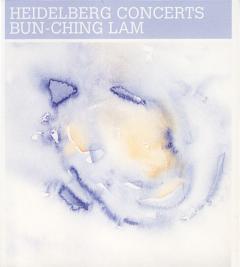BUN-CHING LAM / Heidelberg Concerts
Min Xiao-Fen (pipa); Susanne Serfling (soprano); Willi Fischer (saxophone); Cfaba Asboth (trombone); Naoko Kikuchi (koto); Bernd Mallasch (percussion); Thomas Buckner (baritone); Isabelle Courret (harp); Angelika Bender (flute); Wolfgang Wendel (dizi/xiao); Mariette Leners (viola); Zhang Zhenfang (erhu); Xu Fengxia (Zheng); Jeanne Marie Conquer (violin); Dimitri Vassilakis (piano); Gilles Durot (percussion); Bun-Ching Lam (conductor)
The compositions featured on Disc 1 attempt to translate poetic or artistic sentiments into sound. It presents the many different cultural traits, from Heine to Hiroshige, from Europe to Asia, from Debussy from lunzhi (running finger techniques on the pipa) to Run, that have merged in the musics of Bun-Ching Lam. These pieces show Lam "thinking as a citizen of the world" as one critic, Ken Gallo, put it. Disc 2 presents more chamber music by Lam, under the title of Seeing Sounds-Like Water, Like Ritual: Chamber Music. Each of the pieces is an expressive painting in sound, allowing the audience a multiplicity of sensual experiences: it is not enough to hear, but one must see and smell, taste, feel and be touched by this music.
Run was the first work Lam ever wrote for solo pipa, the Chinese lute with four strings. Nachtgesänge is scored for soprano, baritone saxophone, trombone, marimba and koto, a rather unusal combination of instruments. Lam decided to set three poems of Friedrich Hölderlin in German. Lotosträume is a setting of Heinrich Heine's poem, written for Thomas Buckner. Omi Hakkei refers to the eight scenic views of Omi by Lake Biwa, near Kyoto, Japan. Lü was originally composed for a dance entitled "A Woman Who Roams". It was scored for a large gamut of percussion instruments, ranging from wood, skin to metal. In Six Phenomena there are six movements altogether, depicting each of the six phenomena. As the Buddhist believes that the physical world is just an illusion, I feel music shares the same illusive quality, hence this composition. Bittersweet Music II for violin, is the second of a series of pieces that Lam composed for various solo instruments, mostly virtuosic in nature. …Like Water consists of a series of short self-contained movements. It makes reference to images of water and its various manifestation such as ice, steam, and mist.
Bun-Ching Lam, born in Macao, and Gunnar A. Kaldewey, a book artist born in Germany, have been working together for more than twenty-five years. The artistic outcome of their collaboration was presented in an exhibition of artist books and three evening concerts featuring compositions by Bun-Ching Lam, held in Heidelberg in the fall of 2009. The CDs included here contain the opening concert of October 26th, and the final concert of October 28th, featuring vocal and chamber music written for Asian and European instruments.
TRACK LIST
CD 1:
Run (for pipa solo) (7:25)
Nachtgesänge (for soprano, koto, baritone sax, trombone, marimba)
I. Hälfte des Lebens (3:32)
II.Der Winkel von Hahrdt (2:33)
III.Lebensalter (3:53)
Lotosträume (for baritone and harp) (5:48)
Omi Hakkei (for flute, viola, harp, xiao/dizi erhu, & zheng)
I. Night Rain at Karasaki (2:41)
II.Awazu on a Fine Breezy Day (2:21)
III. Wild Geese Descending in Katata (2:31)
IV. Autumn Moon at Ishiyama (1:57)
V. The Evening Glow of Seta Bridge (2:29)
VI. Sails Returning to Yabase (2:35)
VII. The First Snow of Mt. Hira (1:49)
VIII. The Evening Bell of Mii Temple (1:49)
CD 2
Lü (for solo percussion) (15:38)
Six Phenomena (for solo piano)
I. Phantasm (3:21)
II. Dream (3:32)
III. Bubbles (3:15)
IV. Shadow (3:52)
V. Dew (3:39)
VI. Lightning (1:29)
Bittersweet Music II (for solo violin) (13:20)
...Like Water (for violin, piano and percussion) (27:32)

